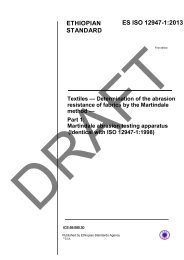AFRICAN STANDARD CD-ARS 861
AFRICAN STANDARD CD-ARS 861
AFRICAN STANDARD CD-ARS 861
Create successful ePaper yourself
Turn your PDF publications into a flip-book with our unique Google optimized e-Paper software.
Introduction<br />
<strong>CD</strong>-<strong>ARS</strong> <strong>861</strong>:2012<br />
Maize flour or maize meal can be considered in fortification programs because they are staple foods<br />
in many parts of the world. For example, in Zambia, over two-thirds of the daily energy intake comes<br />
from maize; in Central America, almost one-half of the daily energy intake comes from maize flour;<br />
and in a number of other countries between 10 and 30 percent of daily energy intake is from maize<br />
flour or maize meal.<br />
The concentration of vitamins and minerals to be added must be calculated based on nutritional<br />
requirements and consumption patterns, after which losses during storage and cooking must also be<br />
considered. Venezuela, for example, fortifies maize flour with a vitamin-mineral premix containing<br />
vitamin A, thiamin, riboflavin, niacin, and iron. Also, certain producers in Zimbabwe and Namibia<br />
fortify maize meal with a vitamin–mineral premix containing vitamin A, thiamin, riboflavin, niacin,<br />
folate, pyridoxine and iron.<br />
This African Standard seeks to establish a uniform regime for fortification which, if adopted, would<br />
make it possible to trade in fortified maize meal or maize flour across the borders of the countries in<br />
the continent.<br />
© <strong>ARS</strong>O 2012 — All rights reserved v



